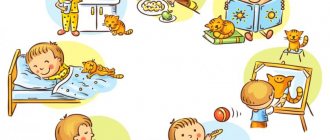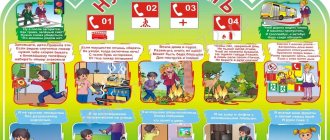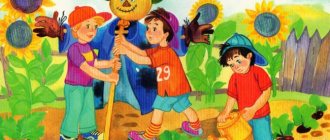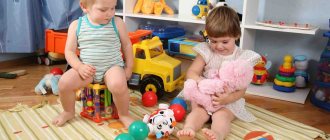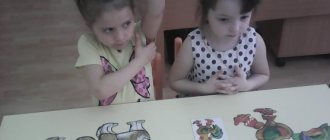Songs to learn the alphabet - video
Songs help you learn the alphabet and remember letters faster and easier. To a cheerful, simple melody, the characters sing about the letters, arranged in the same order as in the alphabet. Get your child interested in the video and offer several options to choose from. Let the child choose the song himself.
If the child is attentive and not only listens, but also watches the video series, choose a song with bright pictures and memorable characters.
your child often get distracted while watching ? A song with only lyrics is enough.
Tip : You can listen and watch videos every day in the first half of the day, when information is perceived easier and faster.
From the alphabet to reading
When a child learns the Russian alphabet, confidently recognizes all the letters in different words and can draw or sculpt them on his own, he should move on to reading. Because learning the alphabet is necessary precisely so that the child can read. If knowledge is not used, it will hang like an unnecessary burden, and by school time it will be forgotten. Therefore, you should not learn the alphabet too early: at 3–4 years old, a child is simply not interested in reading books to learn something new. He is more interested when his mother reads. And vice versa, by the age of six, a child will be glad to have his own books to read them himself.
Exercises to strengthen and develop the speech apparatus
Often, a child pronounces sounds incorrectly because his speech apparatus muscles are poorly developed. Speech therapists offer exercises aimed at strengthening this muscle group. You need to start doing them from the age of 3-4 , so that by the age of 6-7 the child does not have any problems with speech.
- Exercises to strengthen the muscles of the tongue help pronounce the letters “c”, “ch”, “t”, “r”, “sh”, “zh”.
- “Sting” - tense your tongue as much as possible, stick it out and stay in this position for as long as possible.
- “Spatula” - place the tongue on the lower lip.
- “Bowl” - open your mouth, stick out your tongue, do not touch your teeth, stick it back.
- “Pendulum” - open your mouth, stick out your tongue, tense, and move left and right.
- “Horse” , “turkey” - the baby should imitate the clatter of hooves, as well as the cry of a turkey (bl-bl-bl).
- Exercises to strengthen the root of the tongue help to correctly pronounce the sounds “g”, “k”, “x”.
- slight cough;
- imitation of sounds when gargling;
- pronunciation of the vowels “a”, “i”, “e”, but sharply, abruptly.
- Correct closing of the lips helps to pronounce the sounds “b”, “m”, “p”.
- Squeeze the pencil between your lips and describe a circle in the air with it.
- Squeeze a bean or seed with your lips and then sharply spit it out.
- Show how a horse snorts.
- Imitation of drum sounds - boom, bam.
- Cheek training.
- Take turns puffing out your cheeks.
- Puff out your cheeks and imitate chewing food.
- Roll air from one cheek to another.
Fine motor skills help in speech development. Massage your baby's palms regularly. You can use soft brushes, balls, and say jokes for this. Applications, stringing of beads, modeling from plasticine or salt dough are great for developing fine motor skills.
How to learn the alphabet - adapt to the child’s age
3-4 years
To quickly teach a 3-4 year old child, you need to start with simple letters (those that are most often used in speech). After this, gradually move on to complex and rarer ones. This way he will remember the words better and faster.
You only need to learn one letter per lesson. You shouldn’t conduct “lessons” every day - it’s better to do it at intervals of two to three days.
Secure the result using cards, cut out letters from paper or fabric, sculpt from plasticine or dough. Each time before a new sound, repeat the material covered. At 3 years old, a child will be interested in listening to and learning a funny song or rhyme with the alphabet.
At this age, there is no need to force or rush the child. School is not soon yet, quick preparation for it is not required. Conduct classes only at the request of the baby.
It is important to consider the following points when teaching three-year-olds:
- do not expect your child to learn the alphabet quickly (be patient and devote time to studying regularly);
- do not exercise for more than 7 minutes a day;
- learn letters in pairs - A-Z, U-Y;
- do not proceed to study consonants without vowels;
- Remember that at this age imaginative thinking plays a big role, so you need to purchase bright books, toys and pictures.
It’s easier to conduct classes with a four-year-old. At this age, children have more developed processes of perception and analysis of abstract information. You can add puzzles, magnetic letters, cubes to the pictures, attract fairy tales, rhymes, stickers, posters. For better memorization, name the letters and write them immediately, encourage the child to draw them with a pen, pencil, or chalk.
Try an interesting and quite effective technique: forming letters from simple improvised means - buttons, sticks, sand.
You can learn the alphabet with a four-year-old child through the following games:
- cut out letters from paper, and then choose at random and name them;
- show pictures of animals, things, etc., and ask what letter the depicted object begins with;
- learn rhymes and songs with the studied sounds.
5-6 years
5-6 years is the most optimal age for teaching a child the alphabet, and as a result, reading. He must speak and pronounce sounds correctly. If you have difficulties with this, you should visit a speech therapist. At this age, activities cease to be purely playful in nature. The child needs to be told why he needs to know the alphabet. For example, say that now he will be able to read books on his own.
Advice to parents. Five-year-olds can be offered special educational books and notebooks. For example, you should take a closer look at game books with puzzles, mazes, crosswords and other interesting tasks.
⠀
Parents of preschoolers can purchase copybooks in which children will perform various educational tasks. A good option is “First words. Recipes for preschoolers. With tasks. 5-6 years” – publication authored by S.V. Petrenko. This manual is not overloaded with exercises; the words are given in enlarged form. Plus, after completing the task, the child is asked to independently evaluate his work (circle the sun with the appropriate rating) - this will allow the child to feel what it is like to be a schoolchild.
For training, you can use the methods of 4-year-olds (section above). But increase the study time (make the process longer), study every other day and be more persistent. You can also use educational cards and pictures. Assemble letters from puzzles and cut-out parts, sculpt and draw. At this age, a child will be interested in playing with a ball - throw him a ball and say any word, and let him throw the ball back and say the first letter of this word.
After learning vowels and consonants, show your five-year-old how to form syllables.
⠀
The educational material includes cards with syllables that make up words. Before you begin directly teaching your child to add syllables, it is recommended to select several games and exercises with letters. The adult shows the child two cards with letters: a vowel and a consonant, where one letter follows the other, while the parent or teacher pronounces how a syllable is formed from them. For example, the letter L runs towards the letter A, resulting in the syllable “l-l-l-a-a-a”.
An example of a game that helps a child learn syllables
To play you will need scissors, paper and pencils.
The point: the child is asked to draw a car or a house with a window. Make cuts along the side edges of the window. Prepare a paper tape, place the vowels on it: A, O, E, Y, U, I, E, Z (keep in mind that the width of the tape should fit into the cuts on the window). Then glue a transparent pocket - it will be located directly in front of the window (a piece of polyethylene is suitable for this purpose). In this pocket, place the consonant letter L, N, M one by one (choose the simplest letters), then insert a ribbon with moving vowels into the window, stretch it out, showing the child how to form syllables.
7 years
Preschoolers are taught letters using elements of classical classes - books, primers, alphabet, and copybooks. The child needs to be taught not only to pronounce sounds, but also to represent letters in writing. The purpose of the lessons is not only the alphabet, but also learning to organize your own time. The child learns to do homework according to a schedule, at the same time, devoting at least half an hour to completing the work.
After the child has learned the consonants, you can try to form syllables. For this purpose, you can use cubes, puzzles, or draw syllables on the board.
An electronic primer will be a useful acquisition. With its help, the activity turns into an exciting game. When choosing an alphabet book, make sure that the robot pronounces sounds, not letters. In addition, use special workbooks, and also ask your child to talk as much as possible - talk about the past day, retell fairy tales.
The future student will be interested in theoretical lessons in the form of educational cartoons. You can cut out letters and glue them in the form of appliqués.
When sending a child to first grade, a parent worries not only about the level of preparation of his child, but also about the health, safety, and adaptation of the young student to new conditions. To worry less about your child and respond to all problems in a timely manner, buy your student a children’s smart watch or install the “Where are my children” application from the AppStore and GooglePlay. This way you can always know where your child is, what route he is taking, and what is happening around him!
How to learn the alphabet online - 5 proven simulators
When a baby learns the alphabet with a tablet in his hands, the information is remembered more easily, because the child is completely focused on the bright picture. We have selected for you several interesting applications that can be downloaded to your tablet and offered to your child as an alternative to books and posters.
Talking ABC - Alphabet
The application has free and paid content, the tasks are all clear and accessible. In addition, the exercises differ in difficulty level. The kid will be able not only to learn the letter, but also to color it. The application is free, but you can also purchase the full version.
ABC for children
The child learns all the letters of the alphabet from bright pictures. The application interface is simple, accessible, and has sound. Learning occurs not only through pictures, but also through riddles. The application is free.
«Alphabet. Let's learn letters. «
This application is suitable even for the little ones. Especially if your child loves dinosaurs. You can study together with your child - you on the phone, for example, he on the tablet.
ABC coloring book
A real find for children who love to draw. In this application, the baby learns letters, gets acquainted with their writing and shows his creative abilities. An excellent educational game for those who are getting acquainted with the alphabet and are already learning to read. The application is free.
Letters: learning to read is fun
First, the child learns the interactive alphabet, and then can play with the letters. To do this, he needs not only to name the letter, but also to pronounce the sound, and then name the object whose name begins with this letter. The short version of the application is free, the full version is paid.
Learning letters: where to start?
Photo source – www.freepik.com
Before teaching your child letters, you need to decide: 1) whether he is ready to learn, and 2) what goal you are pursuing. If the reason lies in the parents’ desire for the child to know as much as possible in order to show off to others, it is better to leave this idea. The young student himself must show an interest in knowledge and want to learn the alphabet. You need to concentrate on his desires and abilities.
If parents see that their child is inquisitive and shows interest in new knowledge, this is a signal that they can start learning letters. It is important to remember that any theory must be supported by practice. Having learned the letters, proceed to syllables, and then gradually move on to reading.
The main task of parents is to be patient and convey information in an accessible form, and also not to force the child to study if he does not want to. It is better to conduct classes in the form of a game.
You need to start training only if the child himself wants it, or if he will soon go to school. According to the requirements of educational institutions, when entering school, children must know the basics - letters, numbers. Without these basic skills, studying will be much more difficult.
Is your child ready to learn the alphabet?
To determine how ready the baby is, there are psychological tests. Parents are asked to answer yes or no to the following questions:
Development of cognition
- Does the child understand such judgments - right/left, much/little, big/small, low/high, near/far, under/above.
- Can understand simple situations in which it is necessary to divide objects according to classification. For example, identify a group of green and red objects.
- Is he able to think of the end of a fairy tale or story?
- Does he consistently fulfill three requests, without reminding his parents?
Basic knowledge
- Has the child ever been to a post office, a store, or a zoo? How broad his horizons are.
- Have you visited the library?
- Did his parents read fairy tales to him, starting from a very early age?
Speech development
- Is it easy for the child to name the objects that surround him?
- Is it easy to answer the questions asked?
- Is he able to tell the purpose of household things - a vacuum cleaner, an iron, a refrigerator.
- Can he determine the location of objects - on, under, inside, near.
- How clearly does he pronounce words?
- Can he conduct a dialogue?
Development of the emotional sphere
- Is the child having fun with friends and communicating with family?
- Can he adapt to new changes in his daily routine?
- Knows how to compete and cooperate with friends.
Communication level
- Can he share toys and communicate with other children?
- Knows how to listen to others and not interrupt.
Level of physical development
- Is the child diligent, is he able or not to sit quietly for a certain period of time?
- Plays with the ball, jumps, goes down and up the stairs.
- Gets enough sleep, has a good appetite, and knows how to extinguish emotional outbursts.
Development of visual abilities
- Can a child distinguish between similar and dissimilar and classify them into separate groups?
- Distinguishes short words and syllables with similar sounds - forest/weight, cat/year.
- Able to notice changes - if three pictures were shown at first, and then one was removed.
- He knows how to spell his name, what at least three letters from the alphabet look like.
- According to the instructions of an adult, he is able to lay out pictures on the table.
- Knows the order of reading words - from left to right.
- Folds the minimum number of puzzles - from 10.
Hearing development
- Rhymes words.
- Repeats words and numbers after adults.
- Understands that words that are similar in pronunciation have different sounds.
- Retells what he heard.
Interest in reading
- Enjoys looking at the pictures.
- Loves to listen to fairy tales.
- Interested in letters.
Thinking about learning the alphabet in preparation for school? Find out how many words per minute a preschooler and primary school child should read and for what “grade”.
If parents can answer affirmatively to at least 50% of the questions proposed, they can safely offer their child to study the alphabet.
Advice from psychologists
To learn the alphabet with your child, speech therapists and psychologists recommend following these tips:
- do not teach letters strictly in alphabetical order;
- do not learn all the letters mixed together;
- first learn vowels, then consonants;
- name the sound, not the spelling of the letter (incorrect - BE, DE, correct - B, D);
- consolidate what has been learned with practice - show how to write, give the child the opportunity to write with chalk, paints, or with his finger on the cereal.
Talking ABC - poster for learning the alphabet at home
We have prepared for you a review of the most interesting and fascinating alphabet posters. Choose a poster where a voice pronounces the letter and sound. It is important that the child understands the difference between them. Be patient, support the child in everything, help him.
- Talking ABC Expert. This poster contains letters, poems, songs, and the voiceover is clear and understandable.
- ABC. Farm and zoo. Here the child will find fairy tales, letters, numbers, geometric shapes, animal names. The poster is bright, engaging, and the sound is clear and loud.
- Poster Pushkin and Russia. ABC. The canvas depicts characters from the works of Alexander Sergeevich Pushkin, they read poetry, professional voice acting is used. The buttons respond well to pressing and have an auto-off function.
- Safety poster. Azbukvarik . – the poster introduces children not only to letters and sounds, but also to the rules of the road. Very colorful, useful and durable.
- ABC of child safety. Connoisseur. The poster teaches useful and necessary things in life - politeness, correct behavior and, of course, the alphabet. There is a knowledge test function and musical accompaniment.
Training rules
- Play is almost the only opportunity to teach at this age. He must be passionate about what he is studying. Therefore, it is necessary to use various games and aids to make learning the alphabet for young children 4 years old easy and simple.
- Classes should be short, no more than 15 minutes, but quite frequent.
- Training can begin if the child’s oral speech is sufficiently developed. If not, then you need to use the services of a speech therapist.
- If your child suddenly loses interest in activities, then something is going wrong. We need to find out.
- We must remember that a child has every right not to know something and not be able to do something!
Collaborative learning through play is very effective - You cannot compare your child with others. Assuming that someone is better will not produce good results. Each baby is an individual!
- Of course, an individual approach is needed.
- Studying if your child is in a bad mood is a waste of time.
Understanding that moderation and rationality are important in everything will lead to the fact that the baby will master the alphabet quite quickly.
You cannot demand anything beyond the bounds of your child or force him to learn letters.
He should be interested, he should be passionate about the process and want these activities. And if this is not the case, then maybe it’s worth postponing the lessons or trying another, more suitable method? The main thing to remember is that children learn best by playing! leave a comment
How to teach the alphabet in 1st grade
Children begin to learn letters in kindergarten, so in first grade the material is consolidated. Letters are taught not as they are located in the alphabet, but taking into account the phonetic features of letters and sounds.
- Lessons begin with the study of vowels: A, U, O, E, I, Y.
- The next topic is devoted to sonorant consonants - M, L, R, N, as well as the letter Y.
- Then they study consonant letters that form pairs - hard-soft, voiced-voiceless: G-K, D-T, B-P, Z-S, V-F.
- Then they learn the vowels that sound after the soft sign and consist of two letters: E, Yo, Yu, Ya and the soft sign.
- The turn of hissing consonants comes: X, Ch, Shch, Ts and the dividing solid sign .
There is no single methodology for learning letters in 1st grade. The sequence varies depending on the program in which the class is taught, as well as the methodology approved at the school. There are teachers who have developed their own methodology. The standard order for learning letters is as follows:
- Vowels that sound unambiguous;
- Simple consonants;
- Paired consonants;
- Complex letters.
How to teach a child to memorize letters: techniques
There are many interesting and easy ways and techniques in the world to learn the alphabet. They can be presented both in a classic form and in the form of computer games, modeling or special coloring books.
Letter coloring pages
Classic techniques
The basic option for learning the alphabet is to use cards with letters, syllables and images to consolidate associations and develop visual memory. ABC is also a great option to teach basic literacy.
Note! During learning, you should not rush; if the child is tired or has stopped studying, it is difficult for him to remember new things, it is worth taking a break and returning to this moment later.
First, you should memorize the basic vowels (O, U, A, I), and after that move on to simple consonants (M, N, T, B, P, G). The child must learn to pronounce not the name of the letter, but its pronunciation. That is, not “ZhE” “EN” “BE”, but “LJ”, “NN” and “BB”. You should start learning hissing sounds later, when the baby remembers simpler sounds.
It is necessary to teach letters to study both at home and in the fresh, especially summer air: it is worth getting the child interested in recognizing previously learned letters on children's and adult billboards, signs, and English inscriptions online in games.
Author's methods
All conditions have been created, a large number of proprietary methods to learn letters, sounds and the alphabet. Each method has its own advantages and disadvantages.
FEMP classes in the 2nd junior group according to Pomoraeva and Pozina
Important! You should not try to use and combine all methods at once. It is worth focusing on the technique that is comfortable and interesting for the baby to work with.
Learning letters: Polyakov’s game technique
The basis of Polyakov’s method is multiple showing and voicing groups of symbols with their gradual replacement. In the Russian language, groups of rhyming vowels are formed (E-E, A-Ya, O-Yo, Y-I, U-Yu).
The duration of classes is only 7-10 minutes, the frequency is 2 times a week. In your free time, you need to consolidate previously covered material.
This technique uses letter cards and a playful approach, which makes the process easier and more interesting for the child.
Zaitsev cubes
Cubes will help in learning to read from 2 years old. Learning occurs like an exciting game, during which children will begin to read much earlier than they get bored with the activity.
Principles of Zaitsev’s technique:
- Systematic presentation of information.
- Visual presentation of information that uses different channels of perception.
- Presentation of information from specific to general and vice versa.
The main principle of the methodology is teaching not by syllables, but by warehouses. Arrangement is the consonance of a consonant and vowel sound, a separate vowel sound in the form of a syllable or a separate consonant sound in a closed syllable, as well as a consonant with a soft or hard sign.
Doman cards
Doman cards
From birth, the brain is tuned to study and understand the world around us. With this feature, you can begin successful early learning. The technique helps to develop a thirst for knowledge, lays the foundation for a high level of intelligence and helps to learn early reading.
Note! You can use Doman cards for learning from the age of six months.
They represent an image and a word-inscription denoting it. Most often, they are presented in thematic sets.
The sequence is built from simple to complex: it starts with simple words, then phrases and simple sentences are studied, then they move on to common sentences and begin to read.
Methodology of Olga Soboleva
Olga's technique is a creative approach to the process of learning sounds and letters, where the dominant type of memory is involved. The learning process is divided into three information sections for:
- visuals;
- kinesthetics;
- auditory
The learning process is based on a game form with a smooth transition to working with books. It is necessary to help the child love the printed word, and not be afraid of it.
Recommended age for starting classes is 3-4 years.
Alphabet for children 6 years old
Six years of age is considered the best age for perfect memorization of the alphabet and achieving a satisfactory level of reading. Moreover, if a child was unable to learn letters at 3 years old, at 6 years old he will do it 100%, and much faster.
ABCs, primers and magnets can also be used as teaching aids. It is recommended to start using copybooks and watch cartoons that teach letters and the peculiarities of constructing syllables and words. Some also use smartphones and tablets with themed applications, but this point is entirely at your discretion. We still recommend introducing children to books.
And one more thing: don’t be lazy and make an author’s primer with your baby. This is done very simply: a letter and a picture with the corresponding object are drawn on paper. Then all this is cut and pasted into a photo album or pasted into a regular album and reviewed regularly. If you simultaneously purchase simple books for your child, he will quickly master the skill of reading.
Now we will step back from reference to age and introduce you to three proven methods aimed at helping your child master the alphabet.
Alphabet for children 3 years old
As we have already said, the first step in teaching a child the alphabet is to arouse his interest in it. In most cases, curiosity begins to manifest itself during the reading process. Your job is to cultivate and maintain this interest. By the age of three, children often begin to develop their favorite rhymes and fairy tales (if, of course, they were read to them), which means there is motivation to master the alphabet, because in the future the child will be able to read on his own.
So, how to teach a three-year-old child letters:
- Use letter cubes, banners, posters, and magnetic letters
- Draw letters with your child on paper, asphalt, snow, or a special board
- Compose letters from various objects that are at hand (sticks, matches, buttons); This exercise also helps develop fine motor skills.
When interacting with letters, begin to gradually explain to your child their meaning, sound, meaning. But remember that you need to study one letter at a time.
Alphabet for children 4 years old
For four-year-old children, classes are conducted in approximately the same way as in the previous case. The main focus is on games. It is recommended to continue making letters from available items. Be sure to supplement the process with new games. Here are a couple of them:
- Game "Find the picture". Make a set of pictures depicting objects with names beginning with all the letters. Lay out the pictures in front of the baby, name the letter and let him look for an object whose name begins with it.
- Game "Bag of Letters". Cut letters out of cardboard (or use special toy letters) and put them in a small bag. Give your child the task of putting a pen into the bag and trying to identify it by touch. After this, you can take out the letter to check whether the task was completed correctly.

